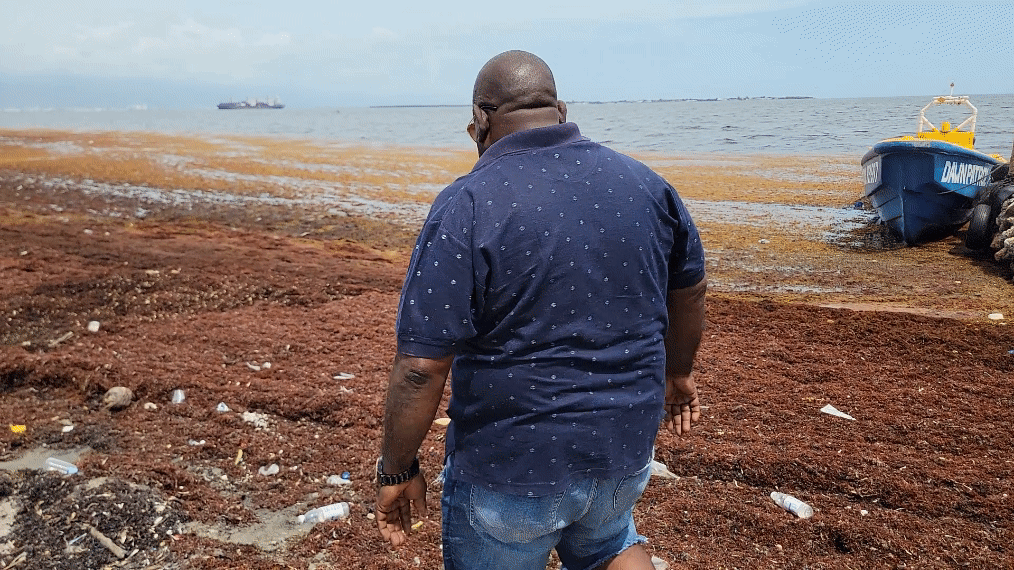During more than half a century of working as a fisherman in Jamaica, Richard Osbourne has seen the industry steadily decline in the face of pollution, climate change, overfishing and other issues.
Then came the sargassum.
Over the past decade, the seaweed has frequently swamped the community of Portland Cottage, where Osbourne operates a small fishing boat. And he believes the problem may be getting worse. In 2023, when he said the scale of the influx was second only to 2022, the seaweed came early and reached a peak in July and August.
Boat engines and other equipment have taken a beating, and attempting to skirt the sargassum blooms means using more petrol, which burns a bigger hole in fishers’ pockets. But Osbourne and his colleagues said the worst of the impact is the reduced catch.
Sargassum “kills the fish; it kills the mangroves, it kills the oysters. Everything that lives in the sea, it damages them, down to the very alligator. A very dangerous thing,” Osbourne said.
Fishers across the Caribbean have experienced similar issues since massive influxes began arriving in the region in 2011.
“It’s a very serious issue, I think, especially because it’s almost an annual occurrence now,” said Melanie Andrews-Bacchus, a Trinidad-based consultant who has worked on fisheries issues in more than a dozen Caribbean countries. “The sargassum is becoming thicker; I guess a lot harder to manage in some instances. …It’s definitely a serious issue for the small-scale fisheries sector especially,” she added.
The extent of the impact, however, is still unknown, according to a September report by the Western Central Atlantic Fisheries Commission, a 34-member regional fisheries body established under the United Nations’ Food and Agriculture Organization.
“The impacts of sargassum influxes on fishermen livelihoods have not yet been fully analysed and documented,” the report stated. “For example, within the fisheries sector there has been a loss of fishing days, reduced catches of flying fish, damage to fishermen engines, and increased operating costs. However, the economic losses associated with these events have not been quantified and calculated.”
Often, fishers are left to face the problem on their own. In Jamaica, many said they have not received help from the State to remove sargassum, and they either have to do it on their own or wait for nature to take care of the problem.
The clean-up efforts that do receive government support often focus on tourist areas, and some fishers have seen improper disposal — such as dumping sargassum in ecologically sensitive areas — that could further damage the natural environment on which their livelihood depends.
A National Sargassum Response Plan for Jamaica was drafted in 2015, and officials at the country’s National Environment and Planning Agency (NEPA) said they use it to guide their response to influxes. But the plan was never officially adopted at the government level, and accounts from fishers and public officials alike suggest that it has not been consistently followed or adequately funded.
In fact, most fishermen interviewed by CPI said they had never heard of it.
Monique Curtis, NEPA’s spokesperson, said that most of the funds set aside to assist in the cleanup of beaches had to be returned because communities and fishers rarely requested them. She said they prefer to clean up themselves or allow the sargassum to disintegrate naturally.
Ministers blamed the lack of education of the public for this and recognized efforts need to be ramped up. They said they would improve education efforts moving forward.
Fishing in Jamaica
Though Jamaica’s economy is largely tourism and service based, the fisheries industry contributes to the livelihoods of more than 100,000 people — nearly 5% of the population, according to the United Nations Food and Agriculture Organisation.
The country also has one of the highest per capita levels of fish consumption in the Americas. Jamaicans eat an average of 26.42 kilograms of seafood per year, ranking eighth out of 35 countries in the Americas, according to 2020 data from the Food and Agriculture Organisation. Six of the seven higher consuming countries — led by Antigua and Barbuda, at 57.12 kilograms per year — are small island states in the Caribbean.
But Jamaica’s industry has long been under threat: In the mid-1990s, catch ranged between 19,000 and 25,000 tons annually, and by 2017 it had dropped to 16,000 tons, according to the FAO.
The sargassum has exacerbated the problem in recent years — because about 95% of the island’s fishing fleet is made up of smaller boats powered by one or two outboard engines that can easily be overwhelmed by the seaweed.
Donovan Haye, Scientific Officer at the Caribbean Coastal Area Management Foundation (C-CAM) in Jamaica, said certain types of fishing, such as net fishing, trawling and line fishing, often are so badly impacted that they are nearly impossible during the sargassum peak season.
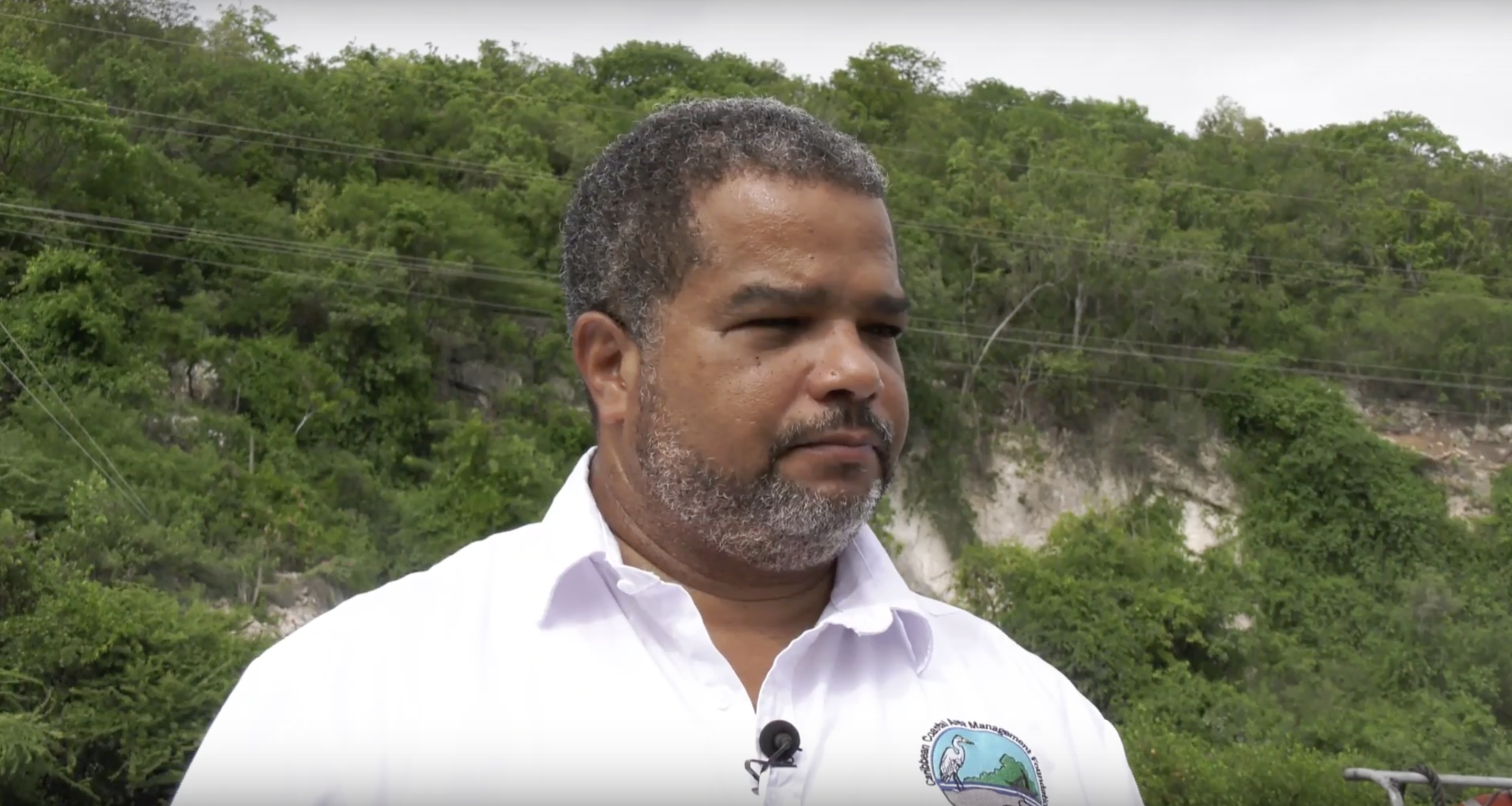
Donovan Haye, scientific officer at the Caribbean Coastal Area Management Foundation, details the impact of sargassum on Jamaica’s south coast of Clarendon.
Photo by Devon Fletcher | Television Jamaica
Strategy
After a particularly bad influx in 2015, Jamaica’s National Environment and Planning Agency (NEPA) drafted the response plan and tapped an emergency fund for about $32,000 to clean up eight beaches and carry out other mitigation efforts.
But since then, clean-ups and funding alike have been limited, and key elements of the plan haven’t been implemented even though NEPA uses it as a working strategy.
The plan, for instance, calls for the creation of a mitigation fund. But this fund was never established, the government acknowledged, and information provided by NEPA for this investigation indicates that the agency has spent less than $10,000 — including about $6,500 from the Tourism Enhancement Fund — on clean-up efforts since 2015. Most of this spending came between 2016 and 2018, after which clean-ups were mostly spearheaded by beach operators and owners, according to NEPA.
The draft plan also calls for the creation of a data collection centre, but NEPA said it hasn’t been established either.
Another major part of the response plan is public education, which is included in two of its four components. But eight years later, five of six fishermen CPI interviewed in three of the parishes badly affected by sargassum said they had never heard of the document.
The only one familiar with it — Devon Malcolm, the secretary of the Half Moon Bay Fishermen’s Co-operative at Hellshire Beach in St. Catherine — said he’s attended several public sensitization sessions with NEPA and the Caribbean Coastal Area Management Foundation (C-CAM), a non-governmental organisation that promotes conservation in Jamaica.
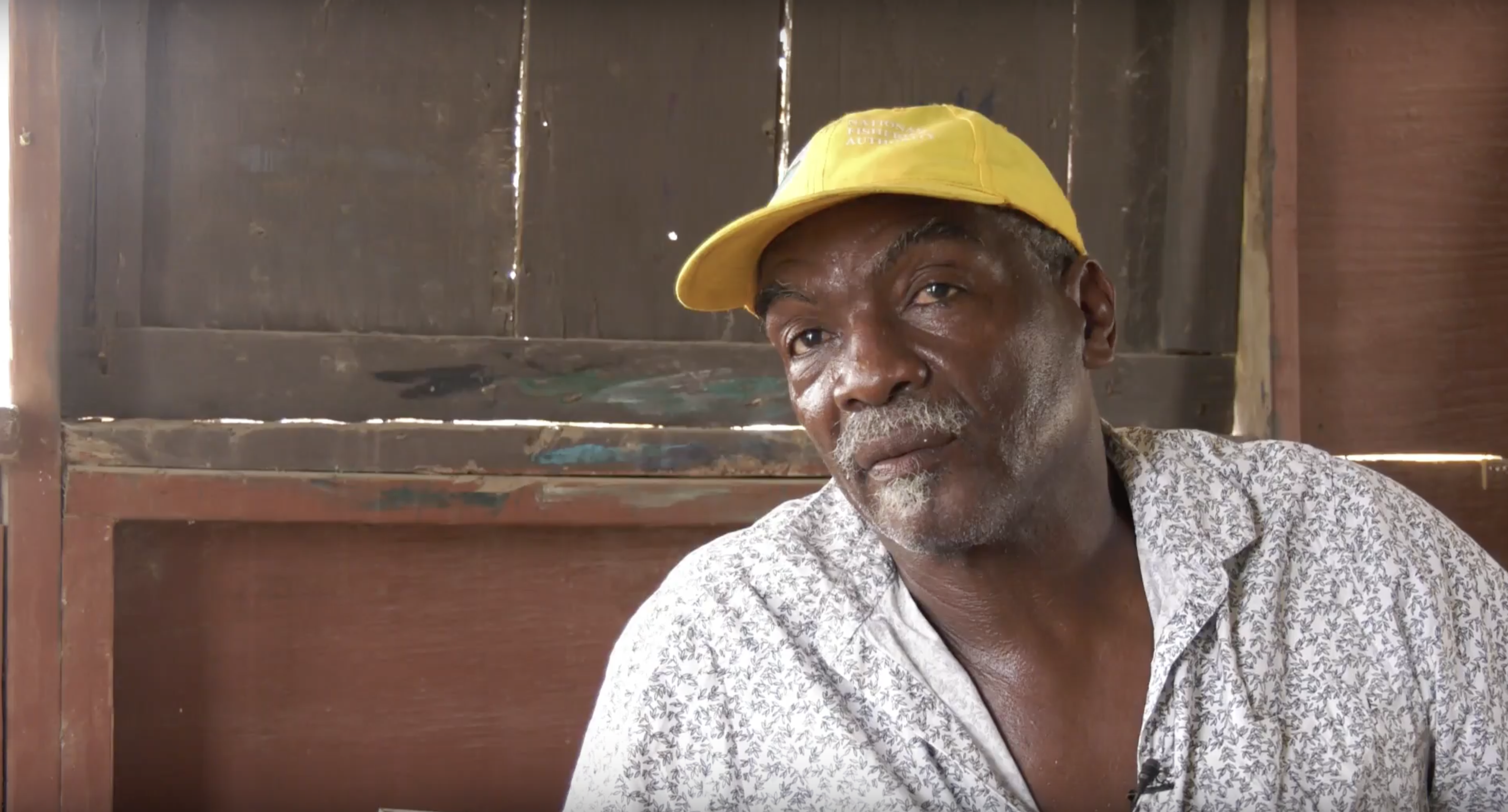
Fisherman Devon Malcolm details his worst experience with sargassum, including a foot injury from direct contact with the toxic floating weed while trying to get his boat out to sea.
Photo by Devon Fletcher | Television Jamaica
But despite such sessions, Haye, the C-CAM Scientific Officer, said that it’s challenging disseminating information about sargassum to all the fishermen who need to know about it, because they’re not all located in one place and do not subscribe to the same type of media.
Fisheries Minister Floyd Green conceded that the government needs to do more to educate fishers about sargassum and to protect them from its negative effects.
“There has been limited support provided over the years when these reports come in, in terms of support to help clean up, but we definitely could do a better job in that regard,” he said.
Despite the fishers’ struggles, he noted that Jamaica has not been affected by sargassum as badly as many other countries in the region.
The assistance the government does provide fishers often is not specific to sargassum, he added: Instead, it addresses the general problems affecting their sector, which also include warming waters and overfishing.
“What we have looked at is a more global context, in terms of some of the bigger issues affecting fisheries,” he said. “You know sargassum is one of the climate-related issues that faces our fishers. … When you combine them, they have really brought a heavy toll on our nearshore fisheries.”
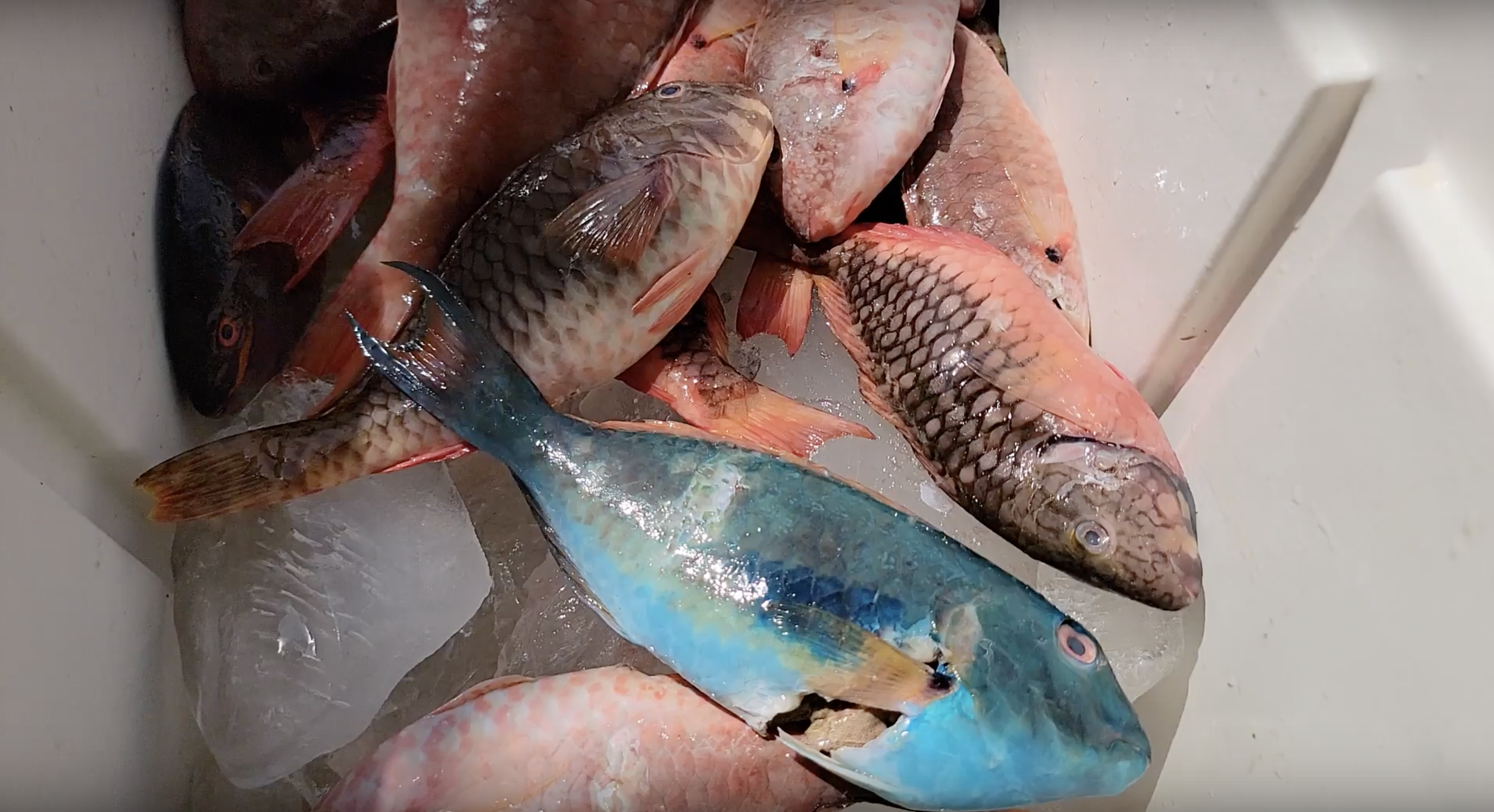
One fisherman at the Portmore Causeway in St. Catherine, Jamaica, showed his reduced catch. Fishers appeal to the authorities to urgently address the sargassum situation before it decimates their livelihood altogether.
Photo by Kirk Wright | Television Jamaica
Government support for such issues, he said, has often focused on helping fishers move further offshore by providing training in long-line techniques and related equipment such as GPS devices.
Huge losses, little help
Haye, however, also lamented that resources are lacking “to compensate fishers” in Jamaica “for any natural disaster event,” let alone sargassum.
Additionally, he noted the challenge to “quantify and determine who has been affected and how, and what level of compensation they require.”
But fishermen are quick to count the cost of sargassum. At the Bluefields Fishing Beach in Westmoreland, located in the south of Jamaica, Kevin Lattibudaire estimated that a major influx of sargassum can cost him up to about $1,300 to $1,900 a month in lost catch.
Osbourne, the Portland Cottage fisherman, said he has seen sargassum irreparably damage up to 100 pounds of fishing net worth almost $8 a pound.
Portland Cottage fisherman Icallie Swaby added that the seaweed has affected his boating equipment. “When it goes into the engine foot, your engine foot can’t turn and it mash up the engine, making it overheat,” Swaby said.
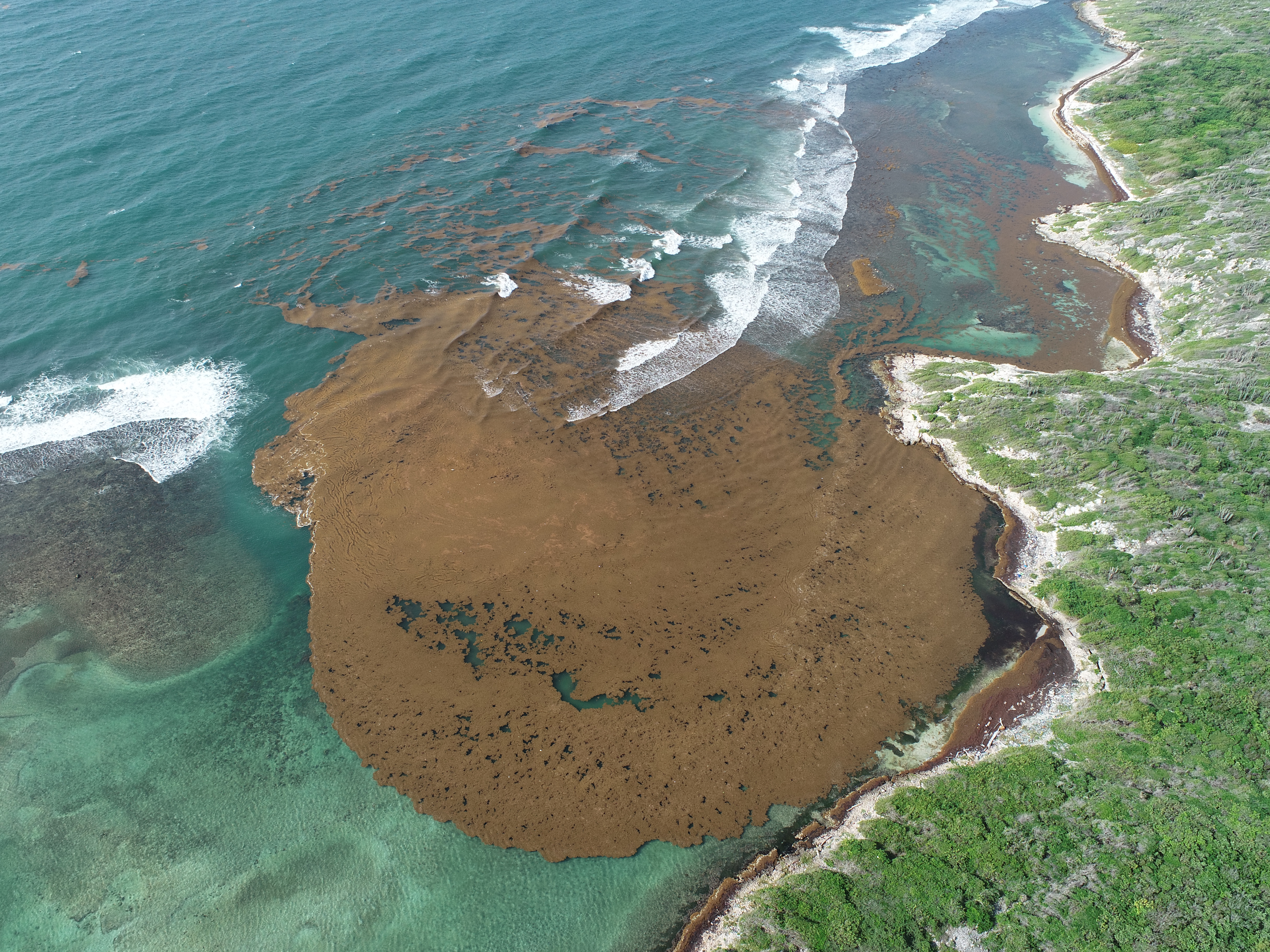
Large sargassum mats sweep into the shoreline in Manchioneal, Portland, Jamaica – one of the worst affected areas in the island.
Photo courtesy of Mona GeoInformatics Institute
And during the worst of any sargassum season, fishers may be unable to go out to sea for days at a time.
Green said the government has not been able to fully determine the cost of the sargassum impact, and so it depends on anecdotal information from affected fishers to assess each season and determine a plan of action.
“Oftentimes, [the fishers’ clean-up] process is not a costed process,” he said. “They do it themselves.”
Clean-up questions
Haye said many tourism operators on popular bathing beaches can often better afford to take matters into their own hands, having the sargassum removed from their premises so it doesn’t affect their businesses.
“The vast majority of the beaches, especially fishing beaches where fishermen normally ply their trade, there isn’t the same level of resources available to devote to that kind of activity,” he said. In the absence of stricter monitoring from the government, Haye worries that tourism operators may not always follow best practices when removing the seaweed.
“It does raise the red flag that just collecting the sargassum from the beach and stockpiling it somewhere where it will deteriorate, you could be removing contamination from one area, putting it in another,” he said.
Malcolm, the St. Catherine fisher, said he has seen sargassum at two nearby beaches being removed only to be dumped “somewhere in Hellshire” with “a lot of sand in it.”
Jodiel Ebanks, the former beaches coordinator at NEPA, pointed to guidelines established under the National Sargassum Response Plan that require written permission from NEPA before collecting and removing the seaweed.
However, NEPA does not have cameras or consistent policing of affected areas to ensure that guidelines are followed, and it depends on reports of breaches to enforce the protocols outlined in the sargassum plan.
‘All of my foot burned off’
Fishers sometimes remove or bury sargassum too, but they worry about health issues that they don’t fully understand.
Wolde Kristos, who manages the Bluefields Fish Sanctuary in Westmoreland, said they often don’t use protective gear or even gloves when handling the seaweed.
Malcolm said he realised there could be harmful chemicals in the sargassum because it bleaches the stones on the shore and kills the small fish that live in these stones.
Then there’s his own experience coming into direct contact with it one day when he was trying to push his boat out to sea through thick sargassum mats.
“When I stepped on it, [it felt like] all of my foot burned off,” he said.
On the southwestern coast of the island, in Bluefields, Westmoreland, the fishermen acknowledged that they are largely ignorant about the risks associated with the seaweed.
“I don’t know much about health-wise,” said Garmell Lattibudaire, adding that he would like to learn all he can.
The fishermen have reason to be concerned. Haye, the C-CAM scientific officer, explained that scientists have identified “abnormally high levels of contaminants” including arsenic in sargassum samples collected from different areas in Jamaica.
Green, the fisheries minister, said he too is concerned about the heavy metals in sargassum and the fact that it has largely fallen on fishermen to “deal with it themselves” so they can still earn money during times of high influxes.
Senator Matthew Samuda, Jamaica’s environment minister, worries about harmful gases like methane that are released when sargassum decays.
Both ministers admitted there has been limited support to fishermen to clean sargassum from their beaches.
“We probably do need to redouble our efforts on public education,” Samuda added.
Green said the state’s future assistance will include training as well as the provision of resources like GPS devices and longline vessels for fishermen to go further out to sea, where sargassum is less of a hindrance to their trade. But this plan has not yet materialised, and he declined to provide details about how it might be funded.
Silver Lining
Despite the struggles, the country has seen progress, including various research and response initiatives based out of the University of the West Indies.
On Jan. 11, 2024, for instance, the Mona GeoInformatics Institute at UWI launched a Sargassum Early Advisory System to help communities — especially tourism and fishing interests — prepare for seaweed accumulations.
A similar system is being used by other regions, including in Ghana. Darren Fletcher, the technical projects coordinator at MGI, stressed that a critical part of adapting to sargassum is “to treat it as an opportunity rather than a nuisance.”
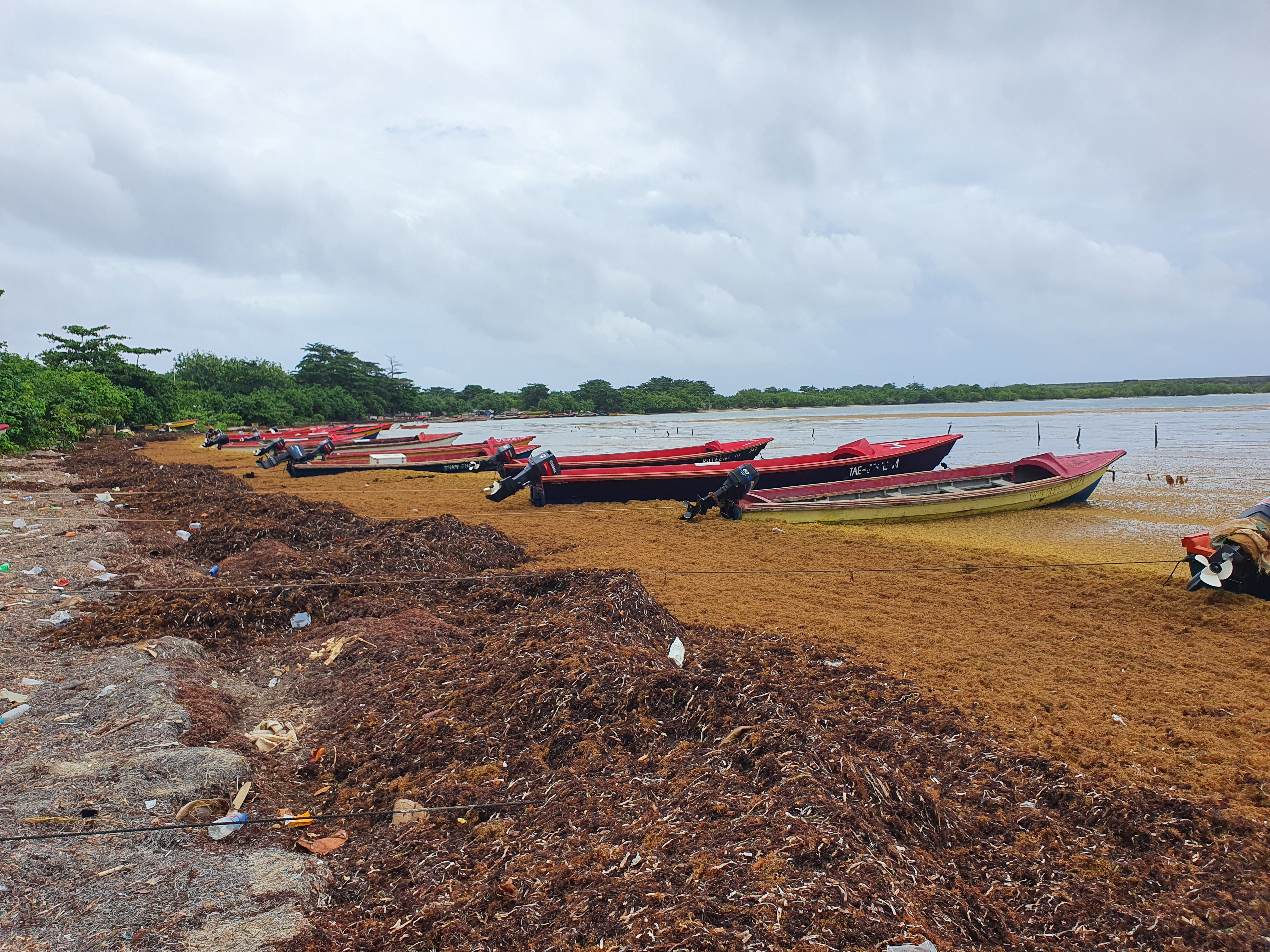
Boats were grounded as sargassum mats swept the shoreline in Manchioneal, Portland, Jamaica – a symbol of the crippling impact on fishing in one of the worst affected zones in the island.
Photo courtesy of Mona GeoInformatics Institute
Haye said predictive technologies like the new advisory system are a step in the right direction, and he argued that they should be combined with techniques for safely removing sargassum at sea before it reaches the shore.
Ultimately, though, he said the world must tackle the sargassum problem in the same way it has addressed ozone depletion in recent decades: with a global response.
“This is not something that we can solve on our own. Like all of these global climate change environmental issues, it is going to require collective action,” he said. “Not to negate the essential need for us to clean up our own backyard, … but we need to be working in partnership on a global scale to address some of these issues.”



